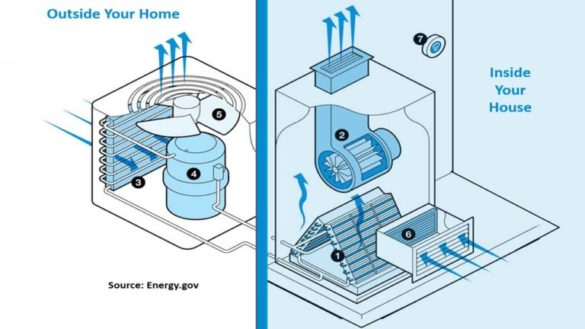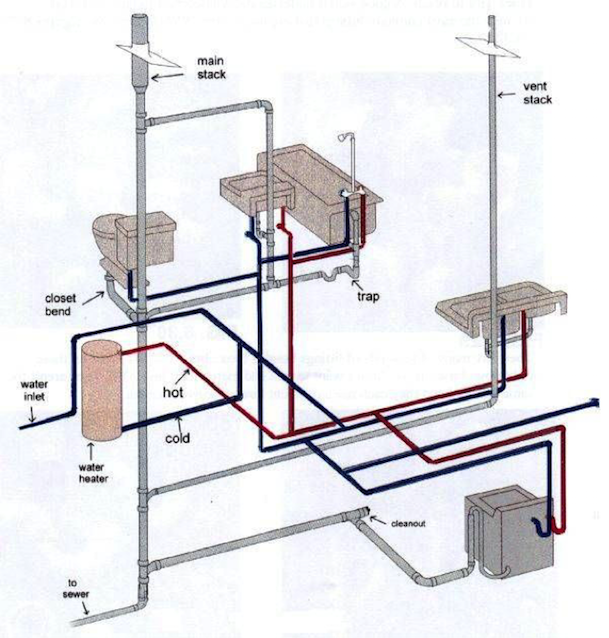The Layout of Your Home's Plumbing System Explained
The Layout of Your Home's Plumbing System Explained
Blog Article
Are you trying to find insight around Plumbing Installation 101: All You Need to Know?

Comprehending exactly how your home's plumbing system functions is essential for each homeowner. From delivering tidy water for alcohol consumption, cooking, and bathing to securely removing wastewater, a properly maintained plumbing system is vital for your family's health and wellness and convenience. In this comprehensive overview, we'll explore the complex network that composes your home's pipes and deal ideas on maintenance, upgrades, and handling usual concerns.
Intro
Your home's pipes system is greater than simply a network of pipelines; it's a complicated system that guarantees you have access to clean water and efficient wastewater elimination. Recognizing its components and just how they interact can aid you avoid expensive repair work and guarantee whatever runs smoothly.
Basic Elements of a Pipes System
Pipes and Tubing
At the heart of your pipes system are the pipes and tubing that bring water throughout your home. These can be made of different materials such as copper, PVC, or PEX, each with its advantages in terms of durability and cost-effectiveness.
Fixtures: Sinks, Toilets, Showers, etc.
Components like sinks, bathrooms, showers, and tubs are where water is made use of in your home. Comprehending how these fixtures link to the pipes system assists in diagnosing problems and intending upgrades.
Valves and Shut-off Factors
Valves regulate the circulation of water in your plumbing system. Shut-off shutoffs are vital during emergency situations or when you require to make repairs, permitting you to separate parts of the system without disrupting water flow to the whole residence.
Water System
Main Water Line
The major water line attaches your home to the local water system or an exclusive well. It's where water enters your home and is distributed to numerous fixtures.
Water Meter and Stress Regulatory Authority
The water meter steps your water usage, while a pressure regulatory authority makes sure that water streams at a safe stress throughout your home's plumbing system, preventing damages to pipelines and components.
Cold Water vs. Warm water Lines
Comprehending the difference in between cold water lines, which supply water straight from the major, and warm water lines, which bring heated water from the water heater, helps in fixing and planning for upgrades.
Drainage System
Drain Pipeline and Traps
Drain pipes lug wastewater away from sinks, showers, and commodes to the sewer or sewage-disposal tank. Catches avoid sewer gases from entering your home and also trap particles that could trigger obstructions.
Air flow Pipes
Ventilation pipes permit air into the drain system, stopping suction that could slow down water drainage and trigger catches to vacant. Appropriate ventilation is necessary for preserving the integrity of your plumbing system.
Relevance of Proper Drain
Making certain proper water drainage protects against backups and water damage. Consistently cleansing drains pipes and maintaining traps can stop expensive repair work and extend the life of your pipes system.
Water Furnace
Types of Hot Water Heater
Water heaters can be tankless or traditional tank-style. Tankless heating units warm water as needed, while storage tanks keep heated water for prompt usage.
Upgrading Your Pipes System
Reasons for Updating
Upgrading to water-efficient fixtures or changing old pipes can enhance water quality, decrease water expenses, and raise the worth of your home.
Modern Pipes Technologies and Their Benefits
Check out technologies like wise leak detectors, water-saving bathrooms, and energy-efficient hot water heater that can save cash and minimize ecological influence.
Cost Factors To Consider and ROI
Calculate the in advance expenses versus long-lasting savings when taking into consideration plumbing upgrades. Lots of upgrades pay for themselves with decreased energy bills and less fixings.
How Water Heaters Connect to the Pipes System
Comprehending exactly how hot water heater link to both the cold water supply and warm water circulation lines aids in diagnosing issues like inadequate hot water or leakages.
Upkeep Tips for Water Heaters
Frequently purging your hot water heater to eliminate sediment, inspecting the temperature level setups, and examining for leaks can extend its life-span and enhance energy efficiency.
Usual Pipes Problems
Leaks and Their Causes
Leaks can happen because of aging pipes, loosened installations, or high water stress. Resolving leaks quickly stops water damage and mold and mildew development.
Obstructions and Clogs
Clogs in drains and commodes are typically triggered by purging non-flushable items or a build-up of oil and hair. Utilizing drainpipe screens and bearing in mind what goes down your drains pipes can avoid blockages.
Indications of Pipes Problems to Expect
Low water stress, slow-moving drains, foul odors, or uncommonly high water bills are indications of possible plumbing troubles that must be addressed immediately.
Pipes Upkeep Tips
Normal Examinations and Checks
Set up yearly pipes examinations to capture concerns early. Seek indicators of leaks, deterioration, or mineral build-up in taps and showerheads.
Do It Yourself Maintenance Tasks
Straightforward jobs like cleansing tap aerators, checking for toilet leakages utilizing dye tablets, or shielding subjected pipelines in chilly environments can stop major plumbing problems.
When to Call a Specialist Plumbing
Know when a pipes concern needs professional experience. Trying intricate repairs without appropriate expertise can bring about more damages and greater fixing prices.
Tips for Reducing Water Usage
Simple habits like taking care of leakages quickly, taking much shorter showers, and running full tons of washing and dishes can save water and reduced your energy bills.
Eco-Friendly Plumbing Options
Consider lasting pipes products like bamboo for flooring, which is durable and eco-friendly, or recycled glass for countertops.
Emergency Preparedness
Steps to Take During a Plumbing Emergency situation
Know where your shut-off shutoffs lie and how to switch off the water in case of a burst pipe or major leak.
Relevance of Having Emergency Situation Contacts Convenient
Maintain call details for neighborhood plumbers or emergency situation services readily offered for fast reaction throughout a pipes dilemma.
Ecological Effect and Preservation
Water-Saving Fixtures and Appliances
Installing low-flow taps, showerheads, and toilets can considerably decrease water usage without compromising efficiency.
Do It Yourself Emergency Fixes (When Appropriate).
Temporary fixes like utilizing air duct tape to patch a dripping pipe or placing a container under a leaking faucet can decrease damages up until a specialist plumbing technician arrives.
Verdict.
Recognizing the composition of your home's pipes system equips you to maintain it properly, saving money and time on repair services. By following regular upkeep regimens and remaining notified regarding contemporary plumbing innovations, you can ensure your plumbing system operates effectively for years to find.
HOW YOUR PLUMBING SYSTEM WORKS
Which Pipes Do What?
Blue lines = fresh water supply entering the building Red lines = hot water supply entering the building Grey lines = pipes carrying waste away from the building and venting pipes carrying gases away from the building (through the roof) YOUR MAIN PLUMBING SYSTEMS
There are two main plumbing systems that support your home s basic plumbing needs one that brings clean water into your home, and one that sends dirty water away from your home. Connected to the toilet, bath, shower, and other faucets in your home, these two systems keep your water flowing in the right directions.
ACCESSING FRESH WATER
Fresh and clean water is brought into your home through the main water supply line . Filtered through one pipe, this water is pressured to flow into the various fixtures in your home at any given time.
This water can be sourced from a well located on your property, a pond or river (mostly cottages), or, as in most cases, from the city s municipal water treatment centre. However, it is important to note that water that is untreated, such as the water siphoned from ponds or rivers, may not be safe to drink. Personal water supplies always need to be treated for hardness and contaminants before consumed.
MUNICIPAL WATER SUPPLIES
Improve taste and odour Remove sediment Eliminate hardness Reduce chlorine COLD WATER SUPPLY VS. HOT WATER SUPPLY
Cold water flows into your home or building through the service line, which then distributes hot or cold water to your fixtures. This line is most commonly run through a central column that runs floor to floor. Hot water runs in short and straight pipes as the longer the pipeline, the more heat that will be lost in the transfer. Having shorter pipes also allows residents to access hot water more quickly.
WASTE WATER SYSTEM
Your wastewater system is divided into two parts pipes that send wastewater away from your home and venting pipes that send sewer gas away from your home. Sewage water travels through pipes that flush the water and waste towards local sewers that are operated and managed by your city or town. Most sewer systems rely on gravity to move the wastewater to where it needs to go.
The further away from your toilet or sink, the larger wastewater pipes become. This allows for waste to be disposed of from various parts of your home or business at once without pipe blockages. The angle and flow of these pipes are also essential for keeping your waste pipes clear of build up.
https://harrisplumbing.ca/how-your-home-plumbing-system-works/

Do you like more info about Plumbing Installation 101: All You Need to Know? Make a remark further down. We'd be pleased to listen to your insights about this review. We hope to see you back again in the near future. If you please take a moment to distribute this entry if you appreciated it. Kudos for being here. Don't forget to come visit our website back soon.
Click Here Report this page